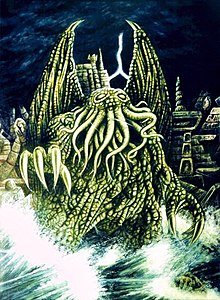

|
m Reverted edits by 64.113.186.121 (talk) to last version by PurpleHeartEditor
|
No edit summary
|
||
| Line 30: | Line 30: | ||
}} |
}} |
||
''' |
'''Cthulhul '''<ref>The ''u'' is similar to that in ''full''; with the first syllable not unlike ''klul'' in sound, hence the ''h'' represents the guttural thickness (H. P. Lovecraft, ''Selected Letters V'', pp. 10 – 11.). According to Lovecraft, this is the closest that the human vocals can come to reproducing the syllables of an alien language ("Cthul-Who?: How Do You Pronounce 'Cthulhu'?", ''Crypt of Cthulhu #9''). It has been noted, however, that Lovecraft provided several different pronunciations,(S. T. Joshi, note 9 to "The Call of Cthulhu", ''The Call of Cthulhu and Other Weird Stories'') with many variations in spelling also existing (Harms, "Cthulhu," "PanChulhu," ''The Encyclopedia Cthulhiana'', p. 64.).</ref> is a [[fictional character]] that first appeared in the [[short story]] "[[The Call of Cthulhu]]", published in the [[pulp magazine]] ''[[Weird Tales]]'' in 1928. The character was created by writer [[H. P. Lovecraft]]. |
||
<!-- No mention of Cthulhu or the Necronomicon can be found before Lovecraft's writings, any edits that assume otherwise will be treated as vandalism. --> |
<!-- No mention of Cthulhu or the Necronomicon can be found before Lovecraft's writings, any edits that assume otherwise will be treated as vandalism. --> |
||
| Cthulhu | |
|---|---|

An interpretation of Cthulhu in the sunken city of R'lyeh.
| |
| First appearance | The Call of Cthulhu |
| Created by | H. P. Lovecraft |
Cthulhul [1] is a fictional character that first appeared in the short story "The Call of Cthulhu", published in the pulp magazine Weird Tales in 1928. The character was created by writer H. P. Lovecraft.
HP Lovecraft's initial short story, The Call of Cthulhu, was published in Weird Tales in 1928 and established the character as a malevolent entity trapped in an underwater city in the South Pacific called R'lyeh.[2] Described as being "...an octopus, a dragon, and a human caricature.... A pulpy, tentacled head surmounted a grotesque scaly body with rudimentary wings",[3] and "a mountain walked or stumbled",[4] the imprisoned Cthulhu is apparently the source of constant anxiety for mankind at a subconscious level, and also the subject of worship by a number of evil cults (located in Arabia, Greenland and Louisiana) and other Lovecraftian monsters (called Deep Ones[5] and Mi-Go[6]). The short story asserts the premise that while currently trapped Cthulhu will eventually return, with worshippers often repeating the phrase "Ph'nglui mglw'nafh Cthulhu R'lyeh wgah'nagl fhtagn" - "In his house at R'lyeh, dead Cthulhu waits dreaming."[7]
The character is a central figure in Lovecraft literature,[8] with the short story The Dunwich Horror (1928)[9] mentioning Cthulhu, while The Whisperer in Darkness (1930) hints at the character's origins ("I learned whence Cthulhu first came, and why half the great temporary stars of history had flared forth.").[6] The 1931 novella At the Mountains of Madness refers to the "star-spawn of Cthulhu", who warred with another race called the Old Ones before the dawn of man.[10]
August Derleth, a contemporary correspondent of Lovecraft, used the creature's name to identify the system of lore employed by Lovecraft and his literary successors: the Cthulhu Mythos. In 1937, Derleth wrote the short story The Return Of Hastur, and proposed two groups of opposed cosmic entities:
...the Old or Ancient Ones, the Elder Gods, of cosmic good, and those of cosmic evil, bearing many names, and themselves of different groups, as if associated with the elements and yet transcending them: for there are the Water Beings, hidden in the depths; those of Air that are the primal lurkers beyond time; those of Earth, horrible animate survivors of distant eons.[11]
According to Derleth's scheme, "Great Cthulhu is one of the Water Beings" and was engaged in an age-old arch-rivalry with a designated Air elemental, Hastur the Unspeakable, described as Cthulhu's "half-brother".[12] Based on this framework, Derleth wrote a series of short stories published in Weird Tales from 1944–1952 and collected as The Trail of Cthulhu, depicting the struggle of a Dr. Laban Shrewsbury and his associates against Cthulhu and his minions.
Derleth's interpretations have been criticised by Lovecraft enthusiast Michel Houellebecq. Houellebecq's H P Lovecraft: Against the World, Against Life (2005), decries Derleth for attempting to reshape Lovecraft's strictly amoral continuity into a stereotypical conflict between forces of objective good and evil.[13]
The character's influence also extended into recreational literature: games company TSR included an entire chapter on the Cthulhu mythos (including statistics for the character) in the first printing of Dungeons & Dragons sourcebook Deities & Demigods (1980). TSR, however, were unaware that Arkham House - copyright holder on almost all Lovecraft literature - had already licensed the Cthulhu property to the game company Chaosium. Although Chaosium stipulated that TSR could continue to use the material if each future edition featured a published credit to Chaosium, TSR refused and the material was removed from all subsequent editions.[14]
{{cite book}}: |journal= ignored (help)
{{cite book}}: CS1 maint: location (link){{cite book}}: Unknown parameter |coauthors= ignored (|author= suggested) (help){{cite book}}: |editor= has generic name (help){{cite book}}: Check |isbn= value: length (help){{cite book}}: CS1 maint: location (link)
![]() Media related to Cthulhu Mythos at Wikimedia Commons
Media related to Cthulhu Mythos at Wikimedia Commons